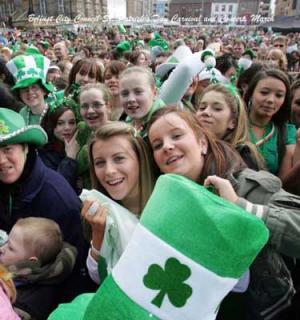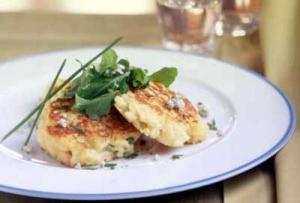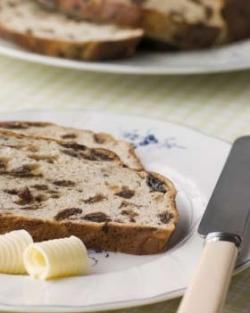
Growing up in an affluent suburb of New York City, I knew I was a mutt – a mix of cultures encompassing countries in Europe and the Near East. However, some of my strongest memories are of my relatives’ pride in their Irish heritage: Their strong work ethic, large families and deep faith. My mother would tell stories about how she and her seven brothers and sisters lived in a cold-water flat growing up, and how her mother always made stews and potato dishes because they went furthest when trying to feed a family of ten. Though they were poor and struggling, they remained proud and devoted Catholics, but that was the extent of my knowledge about this piece of my own culture.
Of course, here in America, on St. Patrick’s Day, everyone is Irish. Ever since the holiday was first commemorated publicly in 1737 in the city of Boston, Americans have celebrated their Irish heritage by marching in parades, wearing green, eating Irish food and drinking beer. Today, 36.3 million U.S. residents boast Irish ancestry, more than eight times the population of Ireland itself! However, while many American families can trace their ethnic heritage back to Irish origins, many of the “traditions” we honor on St. Patrick’s Day actually originated in the United States.
Ask several American celebrants why we honor St. Patrick in March, and you’ll likely get a variety of answers. St. Patrick, the patron saint of Ireland, introduced Christianity to Ireland in the fifth century. He died in Saul, Downpatrick, Ireland, on March 17, 461. Because of the importance of his teachings of Christianity in Ireland, the holiday is a religious one in Ireland rather than secular, and is therefore more subdued. In America, many go to Irish pubs to celebrate with a pint of beer, but in Ireland, up until the late 1970s, pubs remained closed by law on St. Patrick’s Day. Families would instead attend church services, then return home to watch the NYC parade on television. Today, families in Ireland are more likely to sit down to a large family meal of lamb or roast beef rather than corned beef and cabbage on St. Patrick’s Day.
Around the world, celebrants will wear green to show their Irish heritage, but in Ireland, you are more likely to see folks wearing a small bunch of shamrocks pinned to their coats. The three-leaved clovers are worn to symbolize St. Patrick’s teaching of the holy trinity.
St. Patrick’s Day is not the only holiday where traditions differ between the U.S. and Ireland. Although children in Ireland get candy on Halloween today, just a generation ago they would go in groups to houses, and even to pubs, where they would either sing songs or play instruments, and receive money. Another Halloween tradition was to eat “barmbrack” (a kind of yeast fruit bread) to see who would get the hidden penny baked into it. The person who got the penny was supposed to have good luck for the rest of the year. Even though most children didn’t like the taste of the barmbrack, they would eat it anyway, just to try to get the penny.
At Christmas in the U.S., fruitcake has become something of a running joke, a dessert that gets passed around year after year, which no one wants to eat. However, in Ireland, fruitcake is actually a traditional wedding cake. Like multi-tiered American wedding cakes, a traditional Irish cake would have at least two tiers: one would be a lush fruitcake, and the next, slightly smaller, would be soaked in a quality Irish whiskey and stored by the bride and groom. They would later use it as a christening cake for the first-born child. Every guest would receive a slice of cake. Some would eat them, and the single women might take their piece home and place it under their pillow, hoping to dream of their future husband. Today, Irish couples will still have a tier of their wedding cake made of fruitcake.
Irish weddings are even more lavish than in the U.S. Here, a wedding reception is a structured affair usually lasting four to five hours. In Ireland, they go on much longer. It is not unusual for an Irish wedding reception to start at noon with a cocktail hour, followed by a sit down meal, followed by speeches from the father of the bride and groom, the best man and the groom. This would then be followed by a band playing music for about four hours, then more food for another hour, followed by a DJ for three hours! Finally, the night would end with guests at the wedding bringing in instruments and singing songs until the early morning. Some couples may even have “The Strawmen” come to perform. The Strawmen are a group of men who play classic Irish instruments and do classic Irish dancing all while wearing big straw masks. The money they raise goes to charity.
 One food that the Irish population relied heavily upon for their diet in the 19th century is the potato. In fact, by the early 1840s, while most of Ireland’s population ate potatoes in large quantities, for about half them, and almost all of the rural poor, potatoes had become the primary staple of their diet. Because the country depended on only a couple of high-yielding varieties of the tuber, when a root rot fungus arrived in 1845, the potato crops were devastated that year and for the next four, causing what would become known as the Irish Potato Famine. It’s estimated that about one million people – nearly one-eighth of Ireland’s entire population – died from starvation or epidemic disease during those years.
One food that the Irish population relied heavily upon for their diet in the 19th century is the potato. In fact, by the early 1840s, while most of Ireland’s population ate potatoes in large quantities, for about half them, and almost all of the rural poor, potatoes had become the primary staple of their diet. Because the country depended on only a couple of high-yielding varieties of the tuber, when a root rot fungus arrived in 1845, the potato crops were devastated that year and for the next four, causing what would become known as the Irish Potato Famine. It’s estimated that about one million people – nearly one-eighth of Ireland’s entire population – died from starvation or epidemic disease during those years.
In the years that followed, the number of Irish who immigrated to other countries may have reached two million. In fact, this experience was immortalized in many songs, including the Irish ballad,
“The Green Fields of America”
So pack up your sea-stores, consider no longer,
Ten dollars a week is not very bad pay,
With no taxes or tithes to devour up your wages,
When you’re on the green fields of America.
It should be no surprise that many of those who emigrated from Ireland after that dark period still relied heavily on potatoes in their diets, and that many traditional Irish recipes contain potatoes. Make your St. Patrick’s Day celebration a little more traditional this year with an authentic, Irish dish!
The following recipe is for Boxty, a potato pancake of sorts. Boxty is a traditional Irish side dish, celebrated in the old rhyme:
Boxty on the griddle,
boxty in the pan,
If you can’t make boxty,
you’ll never get a man.
The recipe was given to me by my Irish-born friend, Ann McGoldrick Garrity.
Boxty
Ingredients:
1 ½ cups of grated raw potato
1 cup of flour (all purpose)
1 cup of cooked mashed potato
1 egg
1 tablespoon milk
Salt and pepper to taste
¼ cup of oil for cooking in pan
Grate raw potatoes, and pat with some paper towels to get rid of excess water. Toss the potatoes in the flour in a large bowl. Stir in mashed potatoes until combined. In a separate bowl, whisk together the egg and milk. Mix potatoes into egg and milk mixture, and season with salt and pepper. Heat the oil in a large pan. Drop a spoonful of potato mixture in pan and brown on both sides about 3 minutes for each side.
Barmbrack, another Irish bread, is usually eaten at Halloween, but can be enjoyed as a dessert anytime with a cup of tea. Rather than putting just a penny in the bread for good luck, the Irish will hide other little objects as well, with each object holding different significance for those who find them. A ring means you will be married within the year; a pea signifies coming wealth; a bean means impending poverty; and a thimble means spinsterhood.
Barmbrack

Ingredients
2 ½ cups chopped dried mixed fruit
1 ½ cups hot brewed tea
2 1/2 cups flour
1 teaspoon ground cinnamon
½ teaspoon ground nutmeg
½ teaspoon baking soda
1 egg
1 ½ cups sugar
¼ cup lemon marmalade
1 teaspoon grated orange zest
Soak the dried fruit in the hot tea for 2 hours, then drain and gently squeeze out excess tea.
Preheat oven to 350 degrees F (175 degrees C). Grease a 9-inch Bundt pan. Stir together the flour cinnamon, nutmeg, and baking soda; set aside.
Beat the egg, sugar, marmalade, orange zest, and tea-soaked fruit until well combined. Gently fold in the flour until just combined, and then pour into the prepared Bundt pan.
Bake in preheated oven for 1 hour, or until the top of the cake springs back when lightly pressed. Allow to cool in the pan for 2 hours before removing. Continue to cool to room temperature on a wire rack. Press the objects of choice into the cake through the bottom before serving.
Credits: US Census Bureau, Encyclopedia Britannica
